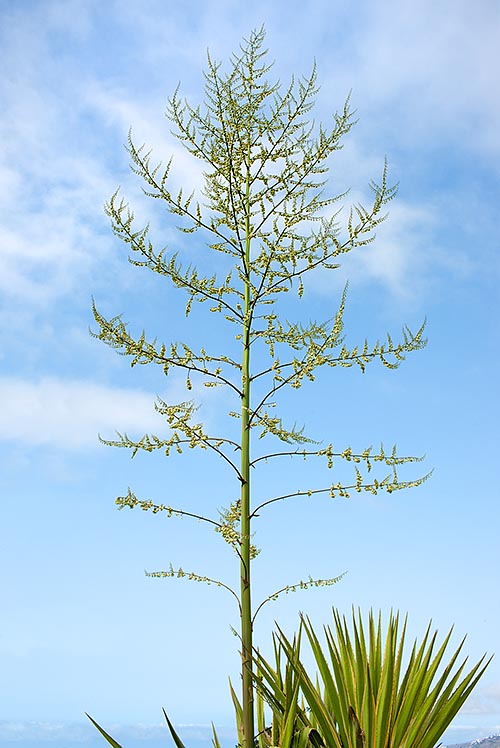Family : Asparagaceae

Text © Pietro Puccio

English translation by Mario Beltramini

Furcraea selloa makes one enormous inflorescence then dies © Giuseppe Mazza
The genus is honoured to the French chemist Antoine François de Fourcroy (1755-1809); the species is honoured to the German botanist Hermann Ludwig Sello (1800-1876).
Common names: false agave, hemp, sword lily, wild sisal (English); agave de Colombie (French); falso agave, fucroya, maguey, maguey de sheljú, magueyón, magueyón macho, pita (Spanish).
The Furcraea selloa K.Koch (1860) is a monocarpic (it flowers only once then dies) succulent species, acaulescent or with stem up to 1,5 m long, endowed with a rosette having numerous (30-50) leaves of about 2,5 m of diameter.
The leaves are lanceolate and narrow at the base, rigid, fleshy, concave above and convex below, 0,8-1,4 m long and 8-15 cm broad, of intense glossy green colour on the upper page, pale green and wrinkly below; the margins have curved teeth, 0,6-0,8 cm long and spaced of 3-4 cm, brown, and the apex of brown grey thorn up to one cm long.
It usually blooms starting from the eighth-tenth year of age, but many more can pass, producing an erect, panicle terminal inflorescence, 6-8 m long, carrying flowers grouped in 2-5, hanging, of 3-5 cm of diameter, with white tepals suffused with green, 2,5-3,5 cm long.
The fruits, rarely produced, are oblong capsules, of about 8 cm of length, containing many seeds; it produces on the inflorescence, on the contrary, a huge quantity of bulbils through which it is usually reproduced; at times, young plants generate at the base which may be detached and placed to root.
Imposing species, of which is particularly diffused a horticultural variety with white or yellow margined leaves, very ornamental, cultivable in the tropical, subtropical climate zones and marginally in the warm temperate ones, where temperatures around the 0 °C are short-lasting exceptions.
It requires full sun and draining soils, utilizable isolated or in groups in vast gardens of desert type, where it needs few cares, as it can stand even long periods of drought, taking care to position it far away from passageways due to its thorns. It can be cultivated in pot, even if the dimensions usually do not encourage this, where it can usually live for many years, utilizing as substratum a mix of loam, sand and gravel, with the maximum possible luminosity, with regular waterings in summer, much reduced or suspended in winter. From the leaves, locally, they get fibres for the production of cordages.
Synonyms: Furcraea flavoviridis Hook. (1860); Furcraea lindenii Jacobi (1869).
→ To appreciate the biodiversity within the ASPARAGACEAE family please click here.
